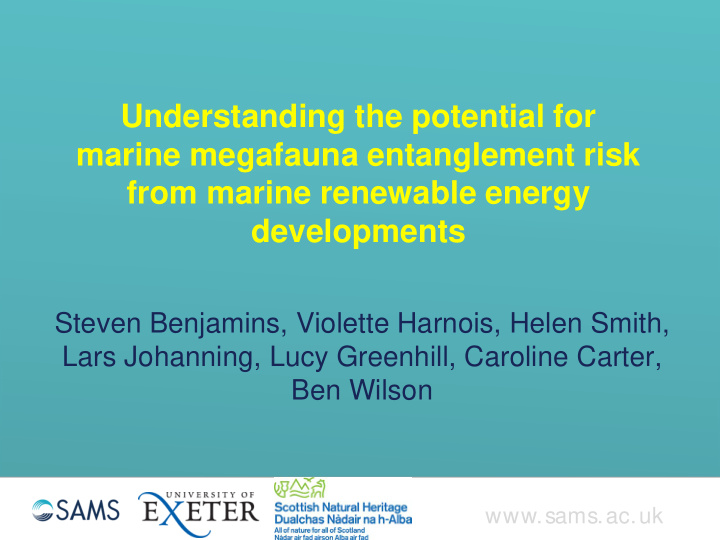



Understanding the potential for marine megafauna entanglement risk from marine renewable energy developments Steven Benjamins, Violette Harnois, Helen Smith, Lars Johanning, Lucy Greenhill, Caroline Carter, Ben Wilson www.sams.ac.uk
Entanglement • Global conservation problem for many species • Involves ropes, chains, etc. • Are MRE moorings a risk? www.sams.ac.uk
Marine megafauna Legal requirements (e.g. EC Habitats Directive) necessitate risk assessment www.sams.ac.uk
Review of entanglement •Fisheries • Aquaculture • Subsea cables • Moorings & anchors Heezen, B.C. 1957. Whales entangled in deep sea cables. Deep Sea Research, 4 , 105-115. Main group of concern: Baleen whales Additional concern: • Derelict fishing gears Photograph was provided courtesy of NOAA Fisheries Alaska Marine Mammal www.sams.ac.uk Stranding Program. Photographs were originally collected under NOAA Fisheries permit snagged in moorings #932-1905. Case study submitted under NOAA Ref. No. KW-KOD2012-FW01
Risk assessment: Mooring modelling • Simulated floating structure • 6 different mooring configurations: – Catenary • With chain • With chain and Nylon • With chain and Polyester – Catenary with accessory buoy – Taut • With Nylon – Taut with accessory buoy • Mooring behaviour was simulated across wave periods of 1-10 s, wave heights of 1, 5, 10 m www.sams.ac.uk
Risk assessment: Mooring modelling • Tension characteristics • Swept volume • Curvature www.sams.ac.uk
Risk factors: Mooring design Catenary with chain/Nylon Taut • Tension characteristics • Swept volume • Curvature Catenary with chain/Nylon Taut www.sams.ac.uk
Risk factors: Mooring design • Tension (high = good; low = bad) • Swept volume (small = good; large = bad) • Curvature (limited = good; large = bad) 3 H = 5 m 3 2 2 1 1 www.sams.ac.uk
Risk factors: Biology • Body size (small = good; large = bad) • Flexibility (flexible = good; rigid = bad) • Sensory systems (long-range = good; short-range = bad) • Feeding mode (pursuit hunting = good; lunge feeding = bad) www.sams.ac.uk
Relative risk assessment Catenary Catenary Catenary & Taut & Catenary Taut & & chain & & chain & accessory accessory Species group & chain nylon nylon polyester buoy buoy Baleen whales Large whales Medium-sized whales Cetaceans Sperm whale Toothed whales Medium-sized whales and dolphins Small whales, dolphins and porpoises Seals Pinnipeds Sea lions/fur seals Sea turtles Basking sharks Sharks Other large sharks Ocean sunfish www.sams.ac.uk
Conclusions • Very limited data on non-fisheries entanglements • Mooring entanglement risk likely low for most megafauna • Possible exception: Baleen whales • Mooring design influences relative risk; assessment approach to be refined as more data become available • Important to consider risk early during project development • Risks around arrays will depend upon device distribution, densities, extent of mooring sharing between devices • Need to assess risk of derelict fishing gears www.sams.ac.uk
Recommend
More recommend